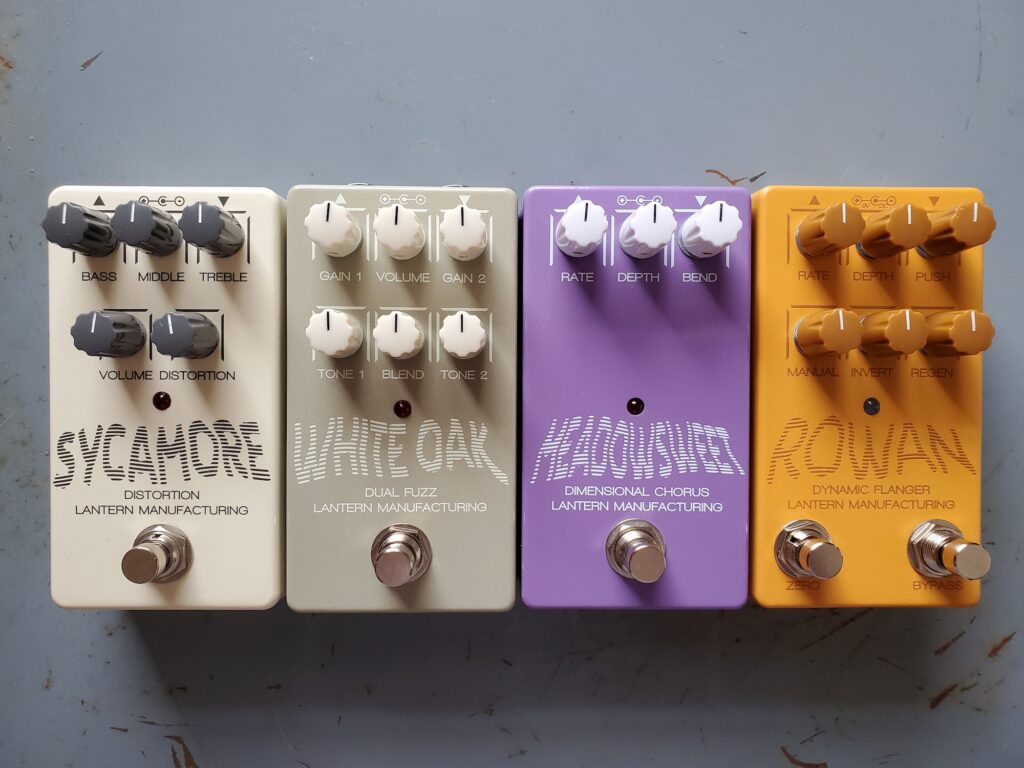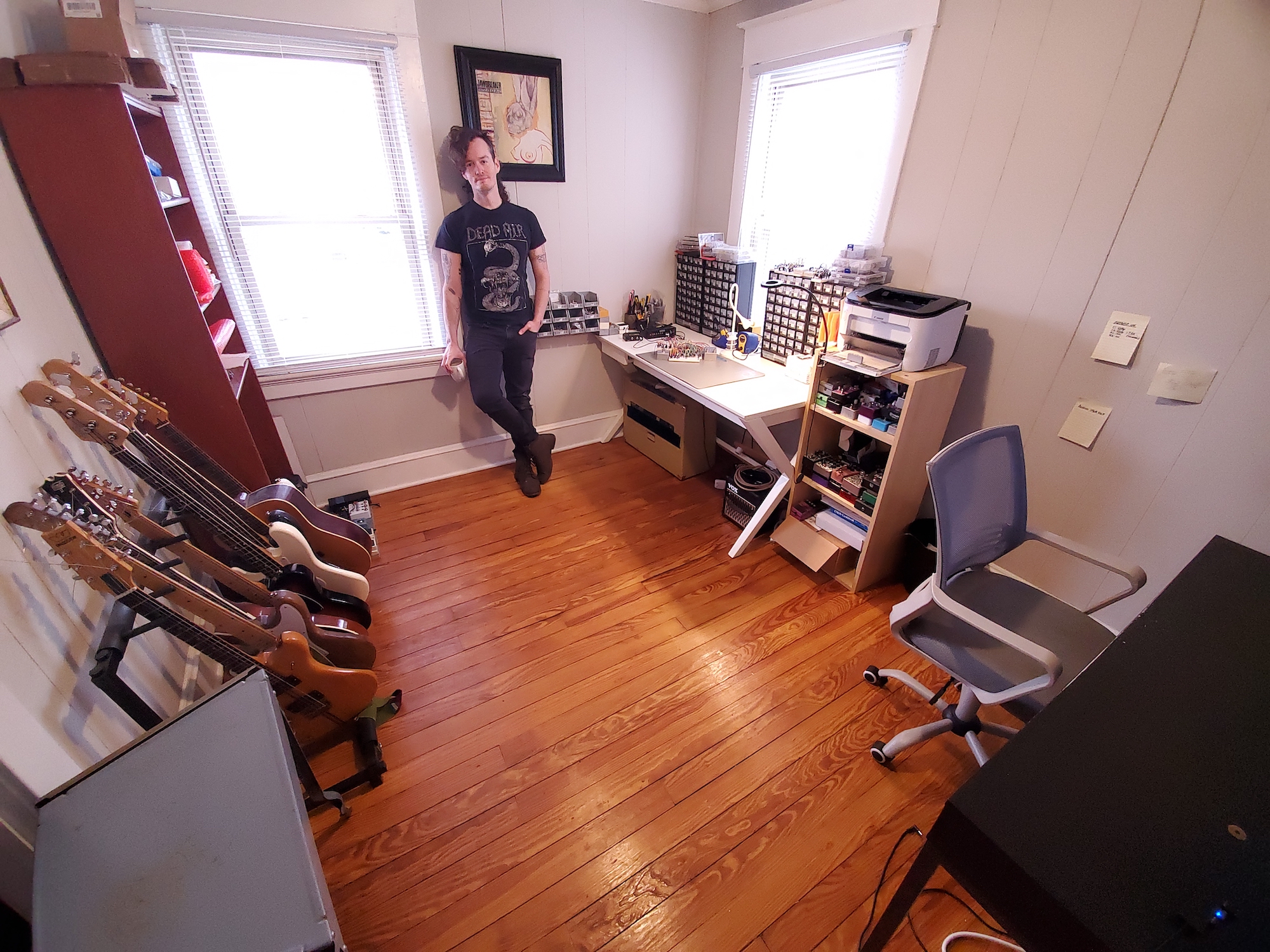While most guitar effects pedal companies are either trying to appeal to customers with some combination of nostalgia/familiarity and/or edgy/modern/rock ‘n’ roll vibes, Lantern Manufacturing went in a very different direction.
As a pandemic-born guitar pedal company, Richmond, Va-based builder Andon Whitehorn’s use of curved fonts, pastel colors and earthy tones would look right at home in a nature-themed interior design catalog. Add in the tree-based naming convention of his pedals (the Meadowsweet chorus, White Oak fuzz, Rowan flanger and Sycamore distortion), and it’s easy to see why Lantern Manufacturing has carved out its own corner of the market on aesthetics.
None of that would matter if Whitehorn’s pedals didn’t sound as good and unique as they looked.
Without getting too far into the weeds of microchips and pedal circuits, Lantern Manufacturing has a tendency to use parts typically intended for other types of guitar effects. The Meadowsweet is a “dimensional” chorus that stems from four delay chips. The Rowan is a “dynamic” flanger that can both go inverted as well as acting like a weird little reverb pedal when needed. In short, all four offerings Whitehorn has created so far are not only great at what they’re supposed to do, but they’re also capable of getting weird and unusual in ways most companies wouldn’t even think to do.
SPIN spoke with Whitehorn about his newfound side business of building unique pedals for a good cause.

SPIN: How did you decide you wanted to launch Lantern Manufacturing during the pandemic?
Andon Whitehorn: Well, like a lot of people, when the pandemic started with the shutdown, I thought “Maybe this is the time to do some things that I’ve always been interested in, but never had the time to actually pursue.” I’ve been playing music for 25 years, and I was always the person who could take care of stuff and fix things. I wasn’t necessarily great at it, but I had a little soldering iron and a box of cables and such. Over the years, I started playing in different bands and accumulating more pedals, just trying to find the sounds and tones I wanted. During the early days of the pandemic, I started looking at the first pedal I ever owned and learned that the setting I had it on that I used for years was basically a Rat with a 3-band EQ. So I thought “Maybe there’s a Rat with a three-band EQ that I could just buy, so I could just use that” — but I looked around and only found stuff that was out of production and going for like $300. Spending that much seemed silly, so I ended up spending a bunch more money to design and build my own. That became the Sycamore, and it turned out that a lot of people had an interest in it.
And after the success of the Sycamore, why did you decide that all of your other pedals would be a pretty big departure from existing circuits?
When it comes to designing things, I like things that are familiar, but off-kilter or asymmetrical. It should be something that sounds unique on paper, but can be relatable and that everyone can enjoy in some capacity. I don’t do things that are weird for the sake of being weird. There are several people who have done very well making these off-the-wall pedal designs that are really cool — but that’s also a narrow niche, and they’ve done it so well that I didn’t even want to try to get into that area. I don’t use any digital signal processing or hard-to-find components. I like to use conventional components that anyone should be able to pick up if they so choose and do the same kind of thing. I think it’s more rewarding to try and suss those sounds or push those sounds out of components that aren’t necessarily built for them, where you have to treat them just right.
So you decided that not only were you going to make unconventional circuits out of common parts, but you were going to do them with effects like a dimensional chorus and a dynamic flanger instead of going with more traditional options like a delay or an overdrive?
The chorus is actually a funny story because it was one of those effects that I enjoyed, but never necessarily appreciated until recently. I always thought it sounded like the ‘80s, and it had its place, but I’d never really sought it out much. But then something clicked and I loved it. I started picking up a bunch of chorus pedals, and it became a bucket list item for when I was designing pedals early on. I figured if I could design a chorus that was really cool and that a few people enjoyed, I’d feel like I’d done something interesting or worthwhile. Usually, everyone just starts out with gain pedals — and I did the same thing, but I always knew that I wanted to focus a lot of time on a chorus.
Aesthetically, you don’t see a whole lot of flowers, leaves and pastel colors in guitar pedals. What was the inspiration behind doing that?
That comes from a mishmash of things, because I do all of the design stuff myself. I was just trying to channel a timeless, retro look where no matter when you looked at it, it would still harken back to a particular time or place. Sometimes when you drive by buildings from different periods of time, some of them have aged very well and look really cool. Other designs, maybe less so. I never set out to have it be something that always stood out, but I just wanted it to always look decent. The colors of the pedals are matched to the color of the tree’s bark or flowers. Anything I do that’s a gain pedal will be named after a tree, and anything that’s more modulation or something will be named after something you might find in the garden or the woods.
Now that you’re a couple years and four pedals into Lantern Manufacturing’s history, what else would you like to do with it?
I just want to be able to keep doing this and pay some bills with it — or at least have it pay for itself — but also check the boxes of having different types of pedals. I’d just like to keep offering things that people dig and that I’m stoked on as well. Hopefully they’re all interesting takes, but also useful takes on conventional things.
What inspired you to donate some of your proceeds to good causes instead of just keeping the funds to grow your business early on?
That came from just growing up in the political punk scene and wanting to have the pedals not only be relatively affordable but also hopefully contributing some good as well. I did a bunch of stuff with the Food Not Bombs chapter in Oklahoma City when I was in high school. I’ve done a bunch of benefit shows and worked with nonprofits. It’s always been important to me. If I can give back in a small way, then that’s cool. There’s a bunch of local mutual aid groups around here in Richmond, and my wife and I have a monthly withdrawal to give money to them to keep maintaining community fridges and harm reduction groups for needle exchange programs and Narcan and things like that, so this was just a natural evolution of that.





